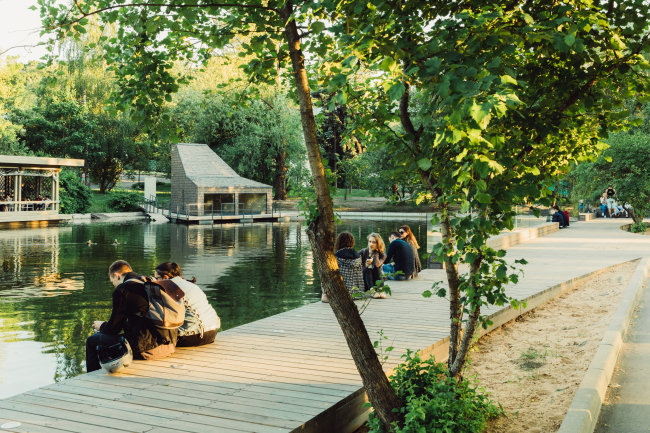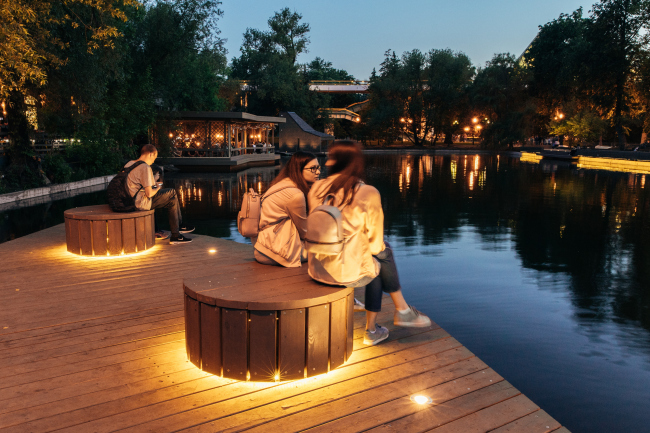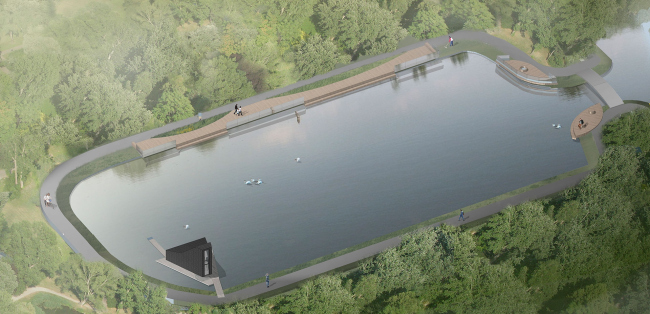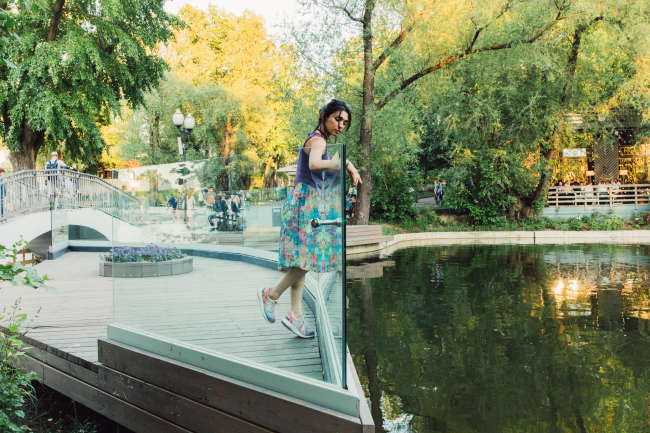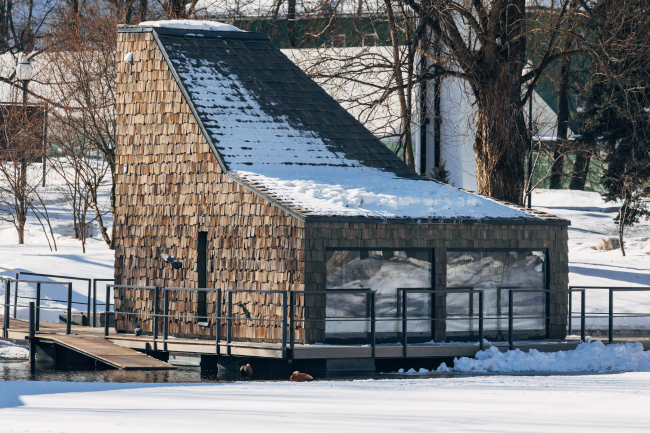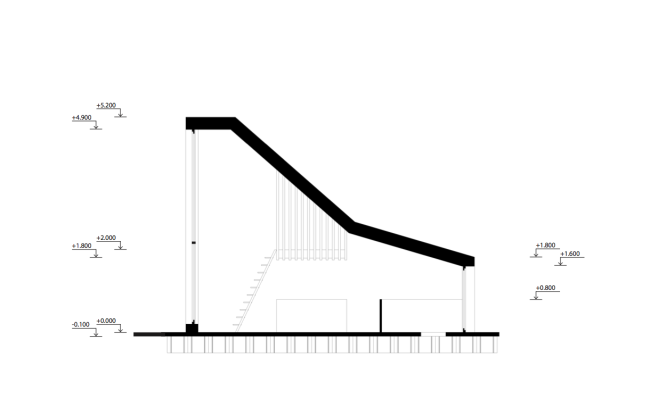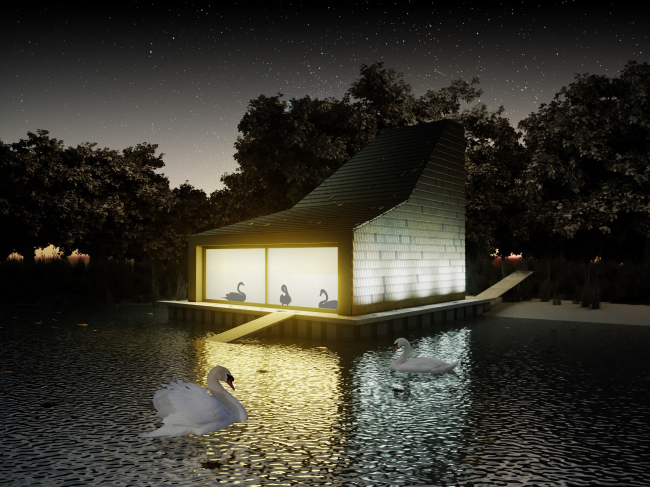|
Published on Archi.ru (https://archi.ru) |
|
| 12.07.2018 | |
|
Where the Swans Live |
|
|
Alyona Kuznetsova |
|
| Architect: | |
| Anton Ladygin | |
| Aleksey Kurkov | |
| Studio: | |
| NRDN | |
|
In the Gorky Park, the Maly Golitsynsky Pond has been landscaped upon the project developed by “People’s Architect”. The place got deck-type embankments and a centerpiece of local importance – a floating pavilion for the swans to live in. Landscaping the Maly Golitsinsky Pond in the Gorky Park © “People’s Architect”. Photograph by Arseniy RossikhinThe Golitsynsky ponds, Maly (minor) and Bolshoi (major) – the Gorky Park’s main reservoirs – are situated amidst the backroads of the park, in the part lying opposite its main entrance. The project of landscaping the Bolshoi Pond was done still in 2011 by Wowhaus; at that time, the place got a boardwalk embankment, a quay, and a café named “Olivkoviy Plyazh” (“Olive Beach”), not far away from the waterfront of the Moskva River. Hitherto, the minor pond has been left devoid of attention: its bank was not reinforced, the shabby birdhouse was falling further into decay, the embankments were not landscaped in any way, and, consequently, even coming near the water was a tricky thing to do. Although the place is far from dead – there is a couple of cafés commanding fine creek views, a rose garden, and swans living here – it still has been falling short of being as “fashionable” as all of the other landscaped zones of the park, and generally, remained “unattached”. Landscaping the Maly Golitsinsky Pond in the Gorky Park © “People’s Architect”. Photograph by Arseniy RossikhinThe team of “People’s Architect” tried to explore the potential of this remote corner of the park, highlighting the beauty of the water and the trees, making a comfortable access to the water and comfortable pedestrian trails, and laying special stress on the swan house that could potentially become the main point of attraction in this part of park. At the same time, the architects wanted to avoid using any heavy structures. At the concept stage, the experience of working with the Izmailovo Park came in very handy, even though that specific project was never implemented. In the Izmailovo Park project, the architects also focused on searching for the “genius loci” and yet-unexplored landscape zones. In addition, they also designed a nursery for domestic animals and birds. Landscaping the Maly Golitsinsky Pond in the Gorky Park © “People’s Architect”. Photograph by Arseniy RossikhinThe Maly Golitsynsky Pond gets circled by a pedestrian trail that separates it from the trees. The space next to the water gets wooden deck terraces, upon which the guests of the park can take a rest enjoying the surrounding scenery. Originally, these terraces were devised as cantilevered structures overhanging above the water but the technical restrictions of working in a park area stopped the architects from implementing this idea. Landscaping the Maly Golitsinsky Pond in the Gorky Park © “People’s Architect”As a result, one embankment stretches almost the entire length of the free side of the pond across from the restaurant and the swan house. Two other embankments of a smaller size are situated on the capes at the transition to the Major Pond – their shape resembles tree leaves. Almost everywhere, there are cascading stairs, sitting on which, one can hang down his legs almost down to the water. Some of the embankments are protected by weightless fences of impact-proof duplex glass. A similar combination – namely, that of wooden boardwalks and translucent fences – was used in the “Zaryadye” hovering bridge. The terraces are already equipped with benches and backlights; soon, there will be flowerbeds as well. Landscaping the Maly Golitsinsky Pond in the Gorky Park © “People’s Architect”Landscaping the Maly Golitsinsky Pond in the Gorky Park © “People’s Architect”. Photograph by Arseniy RossikhinLandscaping the Maly Golitsinsky Pond in the Gorky Park © “People’s Architect”The centerpiece of the pond is the swan house. It came to replace the shabby barn built back in the 1960’s, which was situated in approximately the same spot – on the corner from the side of the Titovsky Drive. The architects decided that the swan house will also perform the role of an art object just as nicely: it is clearly viewable from all sides, yet at the same time no one can really interact with him because only the authorized personnel has access to it. Landscaping the Maly Golitsinsky Pond in the Gorky Park © “People’s Architect”The house is built on a floating base, without either piles or foundation – it can be moved around. Its silhouette is as unusual as functionally justified. The higher part is meant for the staff that will be taking care after the birds; this “loft” will also be the place where hay will be stored. As for the lower part, the swans have it all to themselves. The house stands on a wooden platform that forms a terrace with ladders along its entire perimeter for the birds to easily get down to the water and back again. It is connected to the bank by a small bridge. Landscaping the Maly Golitsinsky Pond in the Gorky Park © “People’s Architect”It was planned that the window would be a pullout one but the operation service said that this entrance would not be used because swans only live in houses in the wintertime, staying outside in summer. In the warm season, the swans are let in through the main entrance. Inside the house, there are small aviaries filled with water for the birds to swim in the wintertime as well; these are also accessed by special ladders. Landscaping the Maly Golitsinsky Pond in the Gorky Park © “People’s Architect”The architects were able to come up with a space that is equally comfortable for birds and people. The birds have water aviaries and so-called “quiet corners” formed by the dead wall and the roof, where they feel safe and secure. The staff will be able to easily come in and clean the aviary, while the visitors of the park will get a chance to watch the birds even when they hide inside the house: thanks to the backlights, the silhouettes of the swans will be seen like in a theater of shadows. Landscaping the Maly Golitsinsky Pond in the Gorky Park © “People’s Architect”The main peculiar feature of the house is its handmade “plumage” of larch singles. The pieces of different sizes create an unusual-looking mottled textured surface – the architects ultimately got a true art object evoking lots of associations: with the old Russian ploughshare, the furnace from the Magic Swan Geese fairy tale, fallen leaves and a forest cabin. As a result of the landscaping work done by the architects, the pond got a “frame” that suggests one to continue his walk down to the furthest corner of the park and stay there a little bit longer. This concept quite falls in with the new “Europeanized” Gorky Park, at the same time sporting new strokes, putting one on the mind of Nikola-Lenivets project. Landscaping the Maly Golitsinsky Pond in the Gorky Park © “People’s Architect”The new projects that they did for the Gorky Park augmented still further the impressive landscaping portfolio of “People’s Architect”: from navigation and small yards to integrated solutions for parks and urban blocks. This specific instance clearly demonstrates the general change of vector in our architecture. While earlier the emerging architectural firms would usually begin with designing small private residences, today, more and more of young companies take up parks and landscaping projects, which is surely a good sign: it is great when one’s way to success starts from caring about many people at once. |
|

